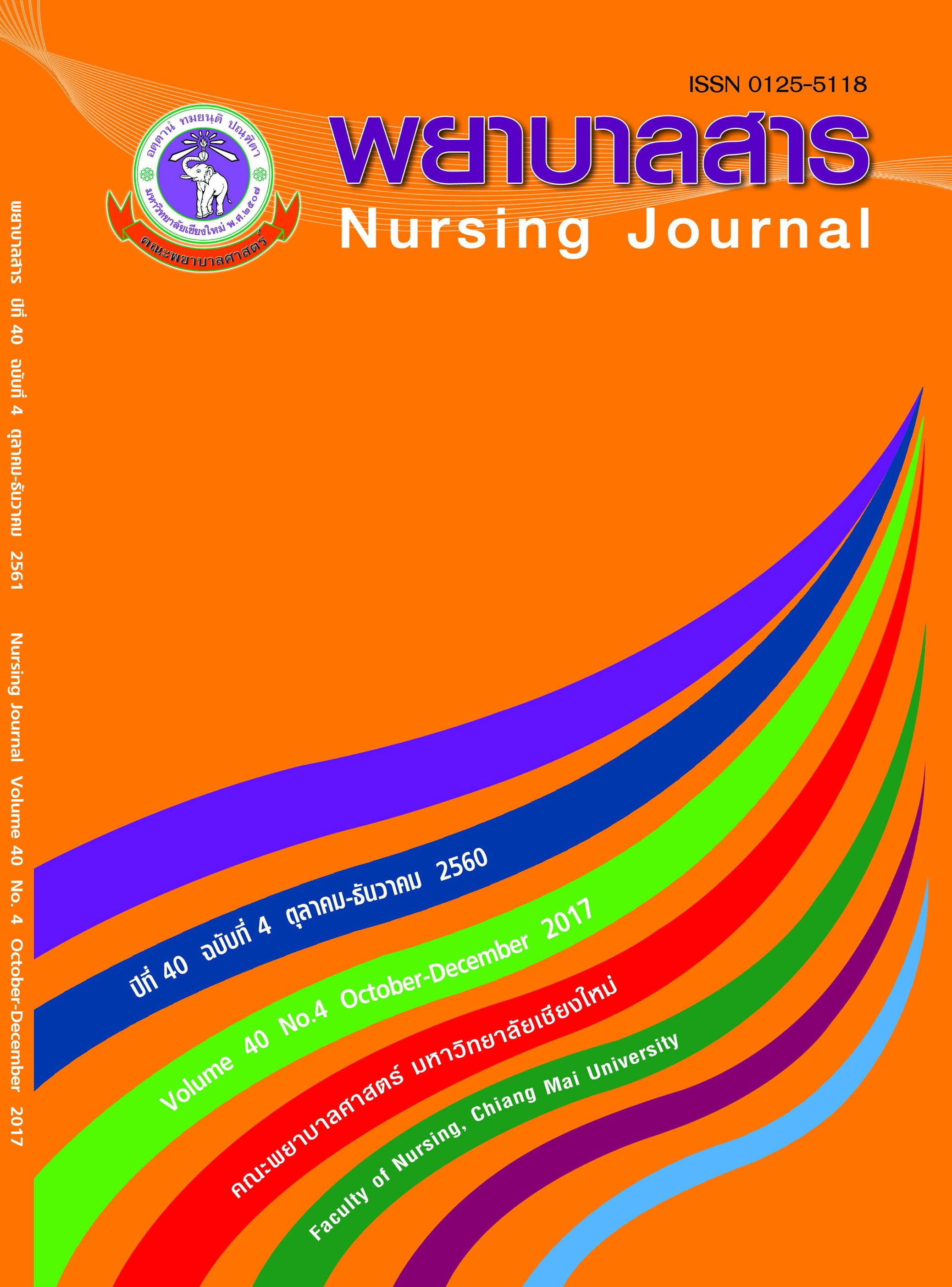Hearing Capacity and Use of Hearing Protection Devices Among Wood Carving Informal Workers
Keywords:
hearing capacity, use of hearing protection devices, wood carving informal workersAbstract
Noise induced hearing loss is a significant occupational health problem. This descriptive correlation study aimed to examine hearing capacity, the use of hearing protection devices, and to test the association between hearing capacity and the use of hearing protection devices among 217 informal wood carving workers at Maetha district, Lumphun province. Data were collected using an audiometer and interviews which have been confirmed for both content validity and reliability. Data analysis were performed using descriptive statistics and Spearman’s rank correlation coefficient.
The study results revealed that only 8.30% of the sample had normal level of hearing capacity while 62.67% and 29.03% were at abnormal and surveillance levels. Only 5.53% of the sample used hearing protection devices, in this case ear plugs. Also it was found that in total use of hearing protection devices including devices selection, wearing and caring for hearing protection devices had a positively significant correlation with hearing capacity at a moderate level (rs = .582-.585, p < .01). Study results indicate that occupational and environmental health nurses including related health teams should recognize the importance of risk communication especially noise in the working environment and encourage the proper use of hearing protection devices. This is anticipated to reduce hearing loss and can result in an improved quality of working life among the informal workforce.
References
ชวพรพรรณ จันทร์ประสิทธิ์, ธานี แก้วธรรมานุกุล, วันเพ็ญ ทรงคำ, และ ญาดาทิพย์ เจริญทรัพย์. (2553). การชี้บ่งปัจจัยคุกคามสุขภาพ ภาวะสุขภาพ การบาดเจ็บและเจ็บป่วยที่เกี่ยวเนื่องกับการทำงาน: การวิเคราะห์สถานการณ์ในอุตสาหกรรมขนาดกลางและขนาดย่อม. พยาบาลสาร, 37(1), 1-14.
ชวพรพรรณ จันทร์ประสิทธิ์, ธานี แก้วธรรมานุกุล, ปิยวรรณ สวัสดิ์สิงห์, ชื่นกมล สุขดี, วรันธรณ์ จงรุ่งโรจน์สกุล, และ วันเพ็ญ ทรงคำ. (2556). การพัฒนารูปแบบการสร้างเสริมสุขภาพและลดภาวะเสี่ยงจากปัจจัยคุกคามสุขภาพ ในการทำงานในอุตสาหกรรมเฟอร์นิเจอร์ไม้: การวิจัยเชิงปฏิบัติการแบบมีส่วนร่วม, คณะพยาบาลศาสตร์ มหาวิทยาลัยเชียงใหม่.
ประไพศรี กาบมาลา, ชวพรพรรณ จันทร์ประสิทธิ์, และ นงค์คราญ วิเศษกุล. (2556). ปัจจัยคุกคามสุขภาพจากการทำงานและภาวะสุขภาพตามความเสี่ยง ของแรงงานนอกระบบแกะสลักไม้. พยาบาลสาร, 40(2), 13-25.
สุภาพร ธารเปี่ยม, ชวพรพรรณ จันทร์ประสิทธิ์, และวันเพ็ญ ทรงคำ. (2550). สมรรถภาพการได้ยินและพฤติกรรมการป้องกันอันตรายจากเสียงของคนงานโรงงานผลิตน้ำตาลทราย. พยาบาลสาร, 34(4), 70-81.
สุริสา ตันชุมพร, ชวพรพรรณ จันทร์ประสิทธิ์, และ วันเพ็ญ ทรงคำ. (2550). ปัจจัยทำนายการใช้อุปกรณ์ป้องกันเสียงในคนงานโรงงานไม้แปรรูปขนาดใหญ่. วารสารวิชาการสาธารณสุข, 17(1), 31-39.
ไอรฎา คงคาชัย. (2553). สมรรถภาพการได้ยินและพฤติกรรมการป้องกันอันตรายของคนงานแผนกทอผ้าในโรงงานอุตสาหกรรมทอผ้า. วิทยานิพนธ์พยาบาลศาสตรมหาบัณฑิต สาขาการพยาบาลอาชีว อนามัย, บัณฑิตวิทยาลัย มหาวิทยาลัยเชียงใหม่.
Ahmad, F. I., Aziah, D., Zaliha, I., & Baharudin, A. (2013). Noise-Induced Hearing Loss Among Quarry Workers in a North-Eastern State of Malaysia: A Study on Knowledge, Attitude and Practice. Oman Medical Journal, 28(5), 331-336.
Daniell, W. E., Swan, S. S., McDaniel, M. M., Camp, J. E., Cohen, M. A., & Stebbins, J. G. (2010). Noise exposure and hearing loss prevention programs after 20 years of regulations in the United States. Occupational and Environmental Medicine, 63, 343-351.
Edwards, C.G., Schwartzbaum, J. A., Lonn, S., Ahlbom, A., & Feychting, M. (2006). Exposure to Loud Noise and Risk of Acoustic Neuroma. American Journal of Epidemiology, 163(4), 327-333.
Jung, D., & Bhattacharyya, N. (2012). Association of hearing loss with decreased employment and income among adults in the United States. Ann Otol Rhinol Laryngol, 121(12), 771-775.
Krejeie, R., & Morgan, D. W. (1970). Determining sample size for reseachactivites. Educational and psychological measurement, 30, 607-610.
McCullagh, M. C. (2011). Effects of a low intensity intervention to increase hearing protector use among noise-exposed workers. American Journal of Industrial Medicine, 54(3), 210-215.
National Institute for Occupational Safety and Health (NIOSH). (1998). Criteria for a recommended standard: Occupational noise exposure revised criteria 1998. Ohio: U.S. Department of Health and Human Services.
Omokhodion. F. O., Adeosun. A. A., Fajola, A. A. (2009). Hearing impairment among mill workers in small scale enterprises in southwest Nigeria. Noise & Health: A Bimonthly Inter-disciplinary. International Journal, 9(36), 75-77
Picard, M., Girard, S. A., Simard, M., Larocque, R., Leroux, T., & Turcotte, F. (2008). Association of work-related accidents with noise exposure in the workplace and noise-induced hearing loss based on the experience of some 240,000 person-years of observation. Accid Anal Prev. 40(5), 1644-1652.
Reddy, R. K., Welch, D., Thorne, P., & Ameratunga, S. (2012). Hearing protection use in manufacturing workers: a qualitative study. Noise & Health: A Bimonthly Inter-disciplinary International Journal, 59(14), 202-209.
Rongo, L., M., B., Barten, F., Msamanga, G., I., Heederik, D., and Dolmans, W., M., V. (2004). Occupational exposure and health problems in small-scale industry workers in Dar es Salaam, Tanzania: a situation analysis. Occupational Medicine, 54, 42-26.
Sataloff, R. T., & Sataloff, J. (2006). Occupational hearing loss (3rded.). New York: Taylor & Francis Group.
Sliwinska-Kowalska, M. & Davis, A. (2012). Noise-induced hearing loss. Noise Health, 14(61), 274-280.
Stephenson, M. T., Witte, K., Vaught, C., Quick, B. L., Booth-Butterfield, S., Patel, D., & Zuckerman, C. (2005). Using persuasive messages to encourage voluntary hearing protection amongcoal miners. Journal of Safety Research, 36(1), 9-17.
Yuwadee, W., & Viroj, T. (2011). Risk of noise-induced sensory hearing loss among wood factory workers, Thailand. Occupational Environment Medication, 68.
Downloads
Published
How to Cite
Issue
Section
License
บทความที่ได้รับการตีพิมพ์เป็นลิขสิทธิ์ของวารสารพยาบาลสาร
ข้อความที่ปรากฏในบทความแต่ละเรื่องในวารสารวิชาการเล่มนี้เป็นความคิดเห็นส่วนตัวของผู้เขียนแต่ละท่านไม่เกี่ยวข้องกับมหาวิทยาลัยเชียงใหม่ และคณาจารย์ท่านอื่นๆในมหาวิทยาลัยฯ แต่อย่างใด ความรับผิดชอบองค์ประกอบทั้งหมดของบทความแต่ละเรื่องเป็นของผู้เขียนแต่ละท่าน หากมีความผิดพลาดใด ๆ ผู้เขียนแต่ละท่านจะรับผิดชอบบทความของตนเองแต่ผู้เดียว






